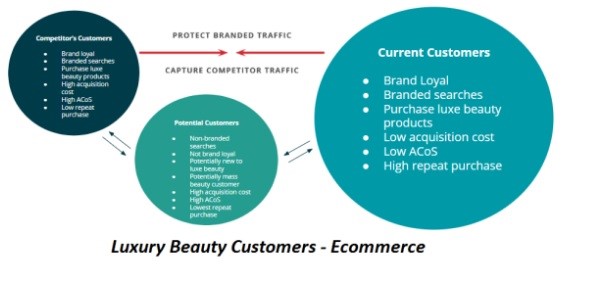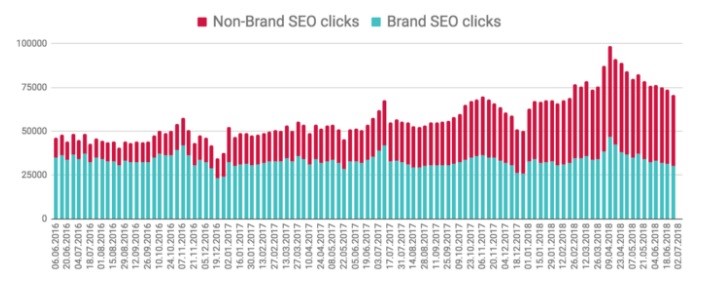It’s no secret that SEO is essential for building the visibility of your site. They are designed to help you achieve specific goals such as:
- Generating brand awareness.
- Driving traffic.
- Achieving specific conversion types.
Experts must focus the SEO and PPC campaigns on the important keywords and terms that drive traffic, despite the evolution of the data generated and used to analyze the outcomes.
Digital marketing experts from SEO Agency highlight that context-focused SEO keywords are most important to be used as per present trends. Moreover, SEO is all about topics. Therefore, it is necessary to build a topical relevance so that you can rank in the top-level generic terms and for long-tail keywords or for how-to queries of customers who want to get more information before buying a product.
Also, if you’re an e-commerce site owner, you must’ve come across terms such as branded and non-branded traffic.
What are these?
Branded traffic is related to and derived from all the branded keywords you can find for the queried domain. It pertains to the traffic or customers who looked for your company in the first place in their queries.
On the other hand, non-branded traffic is derived from keywords that aren’t branded for any domain. But are related to solutions that your company offers. It will include generic keywords that even your competitors target (generic and long tail, informational keywords and queries, and more.).
Together, branded and non-branded traffic comprises a large part of organic traffic coming from real customers. Understand it like this. Branded traffic comprises people looking for a particular company, say ‘A’( Keyword +A). Non-branded traffic comprises solutions that company ‘A’ can offer visitors on its site (keyword).
Why is Branded Traffic Important?
Branded traffic can give you:
- Higher conversion rates.
- Higher engagement metrics
How does brand traffic get generated?
When people hear about your brand from several sources, they will query your brand name in the search engine. This comprises the branded traffic in most cases.
People may also type in your brand with the product they want to buy to land easily on your page.
Therefore, brand traffic is direct traffic and not the one coming from SEO. However, SEO itself helps in increasing brand awareness, thereby contributing indirectly to brand traffic.

To measure your SEO campaign’s effectiveness, it will be necessary to segregate the brand traffic from the non-brand or SEO traffic. However, Google Analytics organic traffic does not provide for this directly.
What will you need to do?
You have to filter out the brand searches while focusing on keywords that are also sourcing traffic to your competitors. If you use these keywords judiciously and optimize the website with them, you will soon be able to override the competition to acquire the top spot in Google search.
Other things you need to do is improve branded traffic.
If you are not in the top position for your popular branded keywords, you must fix this first. This means that if you have been around for a decent time in the market, your company’s name is not a general name. You have to ensure that people searching with your brand must find you at the top. That not only makes things easier for them but also fortifies their trust in your brand.
Focus on the following to achieve this.
- Generic or long-tail term or phrase including branded elements of your company name or your trademarked products. And then, the other steps you will need to take are:
Keeping an eye on brand cannibalization.
You need to set a benchmark for your paid and organic search numbers for branded traffic. Set a baseline.
What you must know
-The total volume
What you need to do
Dig out what is working better. What volume or proportions of branded traffic you’re getting organically and through paid ads.
The analyses can sometimes surprise you. For example, activating your branded paid search may lead to a lowering of the organic traffic.
It may be possible that your ads are only attracting the same traffic you can get through organically.
PPC costs a bomb! And you do not want to lose your money on the traffic you can get anyway through other organic sources.
For companies with a chain of resellers and distributors
Few companies having a significant amount of branded traffic can be the industry of brand chain leaders. In a multi-step channel industry, deriving targeted branded traffic will be crucial and involve several sensitive aspects.
For example, manufacturers selling directly and also via distribution partners are in a sensitive industrial relationship.
That means you might wonder if you need to focus on
- Margins: Which you get by selling directly.
- Volume: Which you attain via resellers. It wouldn’t be right for partners to compete with you.
To solve this dilemma, set sales goals for both criteria. Now reverse engineer on how you can be achieving both things.
You’ll realize that it is better to allow the retailer to spend a few ad dollars while focusing on the organic listings.
Attribution analysis
Branded searches are driven by brand awareness, marketing, sales, referrals, reputation, and all kinds of factors outside the control of search marketers and content strategists.
You need to track it down and separate it from the non-branded or purely SEO traffic.
Find out how much traffic comes from different organic sources and Ads and if you are a multi-step industry service, find what volume you get from your expenditure and through organic traffic is. It will help you to understand where you must spend and what you must target to maximize profits.
Focusing on Non-branded Traffic
A google study in the past years revealed that non-branded traffic could derive a huge volume of new traffic to your website. Factually, a study showed that e-commerce websites get:
- 15 % traffic from branded traffic
- 65% traffic from non branded traffic
The non-brand traffic is based on search engine optimization. It is also seen that brand traffic is the one most related to brand recall.
Therefore, clearly, the non-brand traffic holds the highest importance, which has the highest impact on your sales and revenues.
The overall aim is to get higher organic traffic, and this will be done with the help of SEO.
If you can identify, understand, and manage the gap between branded traffic and unbranded traffic, it will help you know about user intention, ways to improve your services and products, and how to increase your conversion by reaching out to target traffic.
If there are huge gaps in the branded and non-branded traffic, you will have to understand if your company is not offering the services and products that prospective customers are looking for related to your field. You need to identify how you can fill this gap between your brand and what your competitors are offering.
When the gap is less, you are doing a good job and standing high in the competition. And you are offering the solutions that your customers are looking for in your domain.
Understanding the gap between branded and non-branded SEO traffic helps you understand several perspectives, such as improving and getting closer to reaching your goals.
What must companies do?
You will find that marketplace sellers and companies can swell their target groups of
current customers if they target:
- Potential customers
- Competitor’s customers
How it will be done
Companies must look into their:
- Current brand and current non-brand traffic proportions
- Traffic behavior and usage.
Now, here are the steps you will need to take
1. Roping in competition’s customers: It is no wonder your competitors’ customers would not prefer to shop with your brand or become loyal to it. However, they would surely like to buy products similar to what you offer.
A competitor’s customer will initially have a higher cost of sales. Still, once you successfully get them in your marketing funnel, you need to apply remarketing tactics to lower their cost of sales for repeat purchases.

2. Targeting potential customers: In general, these customers will be using non-branded searches. Therefore, if you become brand creative in targeting potential customers, you can get new customers. The strategies you can use include:
- Implementation of good creatives
- Cataloging
The strategy will involve educating the customers and raising their awareness of your brand and products and how they offer value.
Lowering the gap between branded traffic and non-branded traffic will ultimately increase your revenues.
The Conclusion-What leads to the fastest and most desirable outcomes?
It is clear that optimization of your website (on-site and for link building) using the top-performing (generic and long tail, informational, direct purchase, and factual questions) will offer you the fastest improvement for the website’s SEO. You can find out more about ways to increase your organic traffic through branded and non-branded traffic by reaching out to seo for ecommerce. In any case, you have to ensure that you focus on attribution analysis to understand what part of your money is offering you the maximum ROI.
